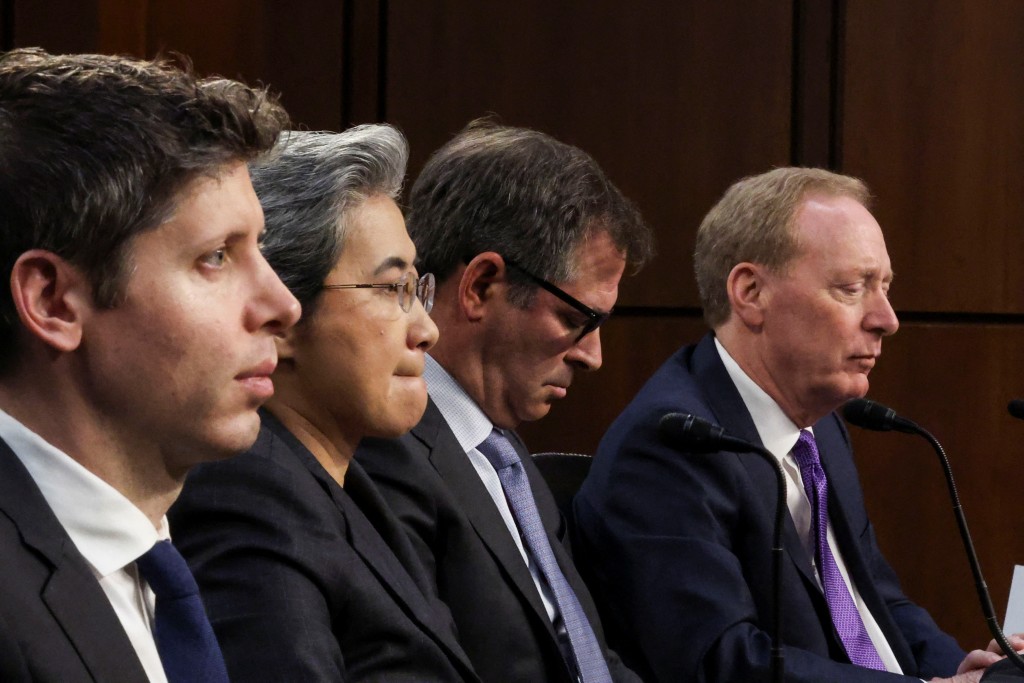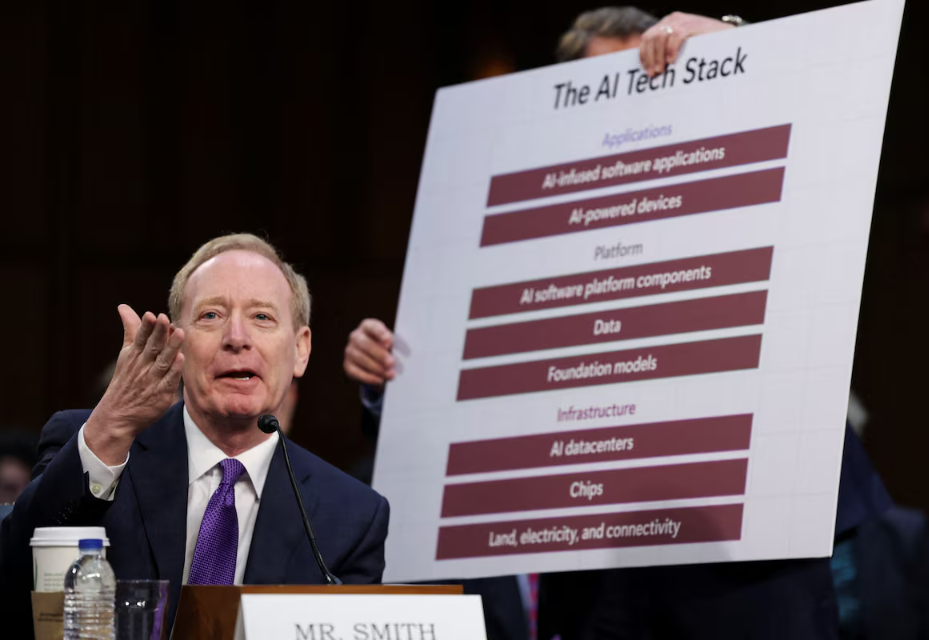China-U.S. competition in the realm of artificial intelligence boils down to development ability. The advantages of the United States are no longer secure. What matters is who will lead sustainably in the future.

OpenAI chief executive Sam Altman; Lisa Su, CEO and chair of Advanced Micro Devices (AMD); Michael Intrator, co-founder and CEO of CoreWeave; and Brad Smith, vice chair and president of the Microsoft Corporation, are seated to testify before a Senate Commerce, Science, and Transportation Committee hearing titled Winning the AI Race: Strengthening US Capabilities in Computing and Innovation, on Capitol Hill in Washington, DC, US, May 8, 2025.
Since the beginning of 2025, the United States has moved steadily to consolidate its dominance in the field of artificial intelligence. Corresponding deployments have accelerated, particularly after DeepSeek’s sensational debut. Driven by such strategic planning as the newly proposed “Artificial Intelligence Action Plan,” the administration of Donald Trump is soliciting opinions from the general public, triggering nationwide discourse about America’s AI strategy.
On April 25, the U.S. government published 10,086 pieces of advice it had collected in the first stage. Such well-known think tanks as RAND and CNAS have also issued a great number of AI-focused reports, concentrating specifically on outcompeting China. Tech giants such as Microsoft, AMD and OpenAI aired their views at a U.S. Senate hearing on May 8 aimed at “winning the AI race.” Judging from the nationwide response and the Trump administration’s recent policy orientation, the mainstream opinions that emerged in the process are gradually turning into policy practices. These, in turn, provide credible clues about what the next steps will be.
Domestically, in addition to a further relaxing of oversight to inspire innovation and competitiveness, the focus will be on addressing areas where America comes up short. China-U.S. AI competition boils down fundamentally to development ability, an area where the U.S. still holds certain advantages. But those advantages are no longer secure. The competition over AI has just begun, and current advantages are not what matters most. Rather, the key question is who will lead sustainably in the future. Therefore, while acknowledging the current U.S. advantages, China feels a pressing need to proactively make up for U.S. weaknesses. These are mainly concentrated in the following aspects:
as AMD’s President Lisa Su noted that the AI industry is energy-intensive, and expanding it will require tremendous energy supplies. U.S. power infrastructure, which is currently mired in cumbersome approval procedures and slow construction, will not meet the needs for AI development.
Microsoft President Brad Smith suggested the U.S. government should consolidate its federal grid approval agencies and improve construction efficiency by means of AI digital instruments. At the same time, it should expand green energy power plants to achieve energy diversification and ensure long-term development of AI technologies supported by sufficient driving power.
Second is data. OpenAI, Microsoft and Google executives believe all current U.S. laws and policies involving copyright, privacy and patent protection prevent U.S. AI models from receiving data for training. The government should not only grant U.S. AI companies the right to access federal databases — thereby acquiring high-quality, large-scale official data for training the AI models but should also proactively promote other countries and regions, such as the European Union. This would allow adjustments to their legal and policy frameworks in the field of copyright protection, so that AI models would be able to reference and extract more intellectual property data and expand the data sources for their legal training.
Third is talent. Nearly 60 percent of leading AI companies in the U.S. were created with participation by high-skill immigrants, according to the Institute for Progress (IFP). Shortages of local tech talent have become the biggest challenge constraining U.S. AI development. Jensen Huang, the head of Nvidia, also noted that half of global AI researchers are Chinese, and that the advantage of indigenous U.S. talent is on a shaky ground. Therefore, many people have suggested the U.S. government should further loosen its immigration policies, raise the ratio of talent staying in the U.S., properly relax checks and constraints on Chinese citizens and try to attract Chinese talent to work in the United States.
At the same time, it should improve the educational regime for STEM disciplines (science, technology, engineering, math) and start AI education in the K-12 (primary education) stage, making it a part of general education for school-age children. It should create a training model that integrates production, education and research; increase the employment matching rate for college graduates, with a particular focus on addressing the talent undersupply for power and data operation maintenance; and come up with vocational training programs for tech workers.
The Trump administration is already making deployments in several areas of weakness based on those suggestions, and the president has signed multiple executive orders to bring on nuclear reactors, enhance power grid construction and promote general AI education, intending to clear the way at the policy level for U.S. AI infrastructure construction and talent cultivation.

Brad Smith, vice chair and president of the Microsoft Corporation, testifies before a Senate Commerce, Science, and Transportation Committee hearing titled “Winning the AI Race: Strengthening U.S. Capabilities in Computing and Innovation,” on Capitol Hill in Washington, D.C., U.S., May 8, 2025. (Photo: Jonathan Ernst/REUTERS)
Internationally, the administration wants to build on U.S. containment of China and focus on continuously strengthening advantages from the level of global ecosystem deployment. The U.S. business community is convinced that either China or the U.S. — whichever assumes the leading position — will be able to make the rules and thus have the ultimate advantage. The party lagging behind will sink in complete disadvantage. So the key to future success lies in the ability to finally dominate the global AI ecosystem. For this reason, the future U.S. foreign policy will emphasize the following two aspects:
• “Optimizing” measures for containing China.
The U.S. business community believes previous export controls on chips have already prevented the U.S. from getting a better position in global markets. They indirectly promoted the process of Chinese self-reliance regarding high-end chips and have fettered U.S. companies’ expansion in overseas markets. Nvidia CEO Huang said in a recent interview that if China could replace Nvidia chips with Huawei chips and realize full-link autonomy in AI training, China may be able to carry out an all-around substitution of U.S. technologies globally, thereby undermining U.S. tech advantages.
So U.S. measures against China should pursue “balance” and “practical effects,” rather than modeling the Chinese adage of single-mindedly “killing 1,000 enemies while losing 800 of one’s own.” The U.S. needs to find an “optimum” equilibrium point between containing development and securing market share in China, as well as controlling the route of technology development.
• Accelerating a global AI ecosystem.
The head of the computing team at RAND’s Center for Technology and Security Policy pointed out that the key to global industry dominance usually lies in the ability to promote technology at large-scale, rather than technological breakthroughs in the lab. Hence the U.S. must promote its AI technologies and services to more places in the world. There have been various signs the U.S. government has adopted this idea and is moving swiftly to grab market share globally. The Trump administration is carrying out “chips for capital”, engaging in investment and tariffs negotiations with allies through loosening chips sanctions, taking full advantage of U.S. technological advantages and policy tools to occupy global markets. It has so far reached agreements with Gulf states on chips export and data center construction.
Besides the U.S. government, tech giants have also become part of the vanguard in expanding U.S. overseas markets. Trump’s entourage of ultra-strong tech-giants on his recent trip to the Middle East was especially eye-catching. In addition, taking advantage of the Stargate initiative, tech giants are continuously expanding global markets for AI infrastructure construction. OpenAI, for one, following its Stargate UAE project, is planning to seek opportunities for further cooperation in such countries as South Korea, Singapore, Australia, India and Japan.
